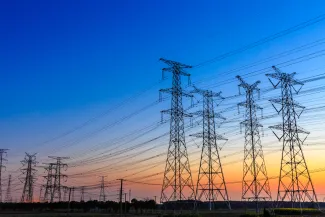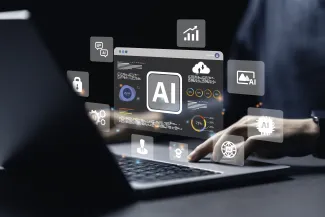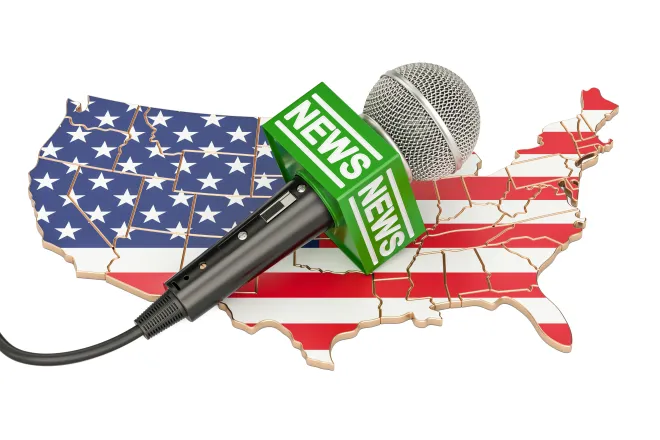
Environmentalists say they’re cautious to adopt AI into their work
Environmental scientists and conservationists have been slow to embrace artificial intelligence tools, in large part because of the enormous amount of electricity the technology demands.
But that, some say, is slowly changing as the potential benefits of AI become clearer.
“I’m not a huge AI fan. If I can avoid it, I do, because I always think about the environmental implications first,” California-based sustainability consultant Jennifer Brandon said. “But I am starting to see it around me and see the benefits of it, especially with these huge data sets that we have.”

© zhaojiankang - iStock-802436842
In one recent example, an Arizona State University climate tech project provides up-to-date water conservation information and suggestions for responsible water use over the last year via a simple, personable chatbot called “Blue.”
While Blue has given residents an easy, personalized resource to understand the state of water needs across the state, the environmental workers and researchers behind it carefully measure the overall impact of the project. Blue has been optimized to use less energy than similar tools, in a nod to the environmental mission of the project. Current artificial intelligence systems require enormous power to drive data centers, and water to keep them cool.
“I think that it is not necessarily as clear to everyday Americans, about the connection between the development of AI and the physical infrastructure behind the technology and the subsequent energy, water and land use,” said Dave White, the director of the Global Institute of Sustainability and Innovation at ASU.
Tech innovation over the last decade has expanded the ways environmentalists can explore sustainability and conservation strategies, White said. But the decision to use newer tech tools, like AI models, which require physical infrastructure and large amounts of energy, water and other resources, isn’t a straightforward one for those interested in conservation.
Concerns that AI’s spotty factual accuracy could be a problem in the highly regulated world of environmental projects have also slowed the adoption of AI by those working in it.
For White and others, however, the potential gains made in the environmental sector need to be weighed against the negative environmental impact the technology creates.
“Sustainability is all about consideration of trade offs,” White said. “Can we get to net positive, where the energy consumption for the data centers that are backing AI is worth the value of gains that we’re potentially seeing on the conservation side? That’s where I would frankly say there’s not nearly enough critical evaluation and questioning of that issue.”
How is AI used in Environmental work?
Blue is one example of the tech-forward projects that the university is developing for more sustainability in the climate, energy, water and agriculture sectors. The Julie Ann Wrigley Global Futures Laboratory launched the chatbot after receiving a $40 million investment from a statewide project within ASU, the Arizona Water Innovation Initiative, which brings industrial, municipal, agricultural, tribal and international partners together to try new strategies for water conservation.
White said that the best uses of AI that the University’s research projects have found have been in modeling, monitoring, management, prediction, simulation and scenario planning. An example of that is a recent study that used satellite observations, land surface models and data to track changes in total water storage in the Colorado River basin.

© iStock - leolintang
“With new technology also, we’re able to link things like satellite-based observations with computer models that incorporate climate change and have that information inform our water resource management agency to help them be more efficient in the way that they manage the existing resources,” he said.
Outside of the university, White said he’s seen AI successfully help within the energy sector with demand management — modeling when equipment may break down or scheduling the optimal use of grid operations.
“I would say climate change, adaptation, mitigation is one area where we’re seeing promise,” White said. “In climate, we’re looking at opportunities where these AI-enabled tools, particularly those that are integrated with control systems and operating systems, can really help to optimize.”
Brandon said she’s seen some form of AI use in the sector for at least a decade. She remembers a classmate developing a machine learning algorithm to identify plankton during one of her Ph.D. lab courses.
“We could suddenly sort all of these images so much faster,” Brandon said. “And so there’s a lot of things like that. They are trying to train AI on databases to see huge patterns of that data that would take us years and years to see those same patterns.”
Brandon also mentioned the growing practice of tracking carbon credits on blockchain, a distributed public ledger that isn’t AI based, but is often used in conjunction with AI technologies. Brandon said the carbon market hasn’t taken off previously because carbon credits weren’t easy to track, but blockchain provides transparency with a signature attached to each credit.
What’s holding environmentalists back?
Brandon described herself as more cautious about AI than some of her colleagues — “I’m an AI skeptic,” she said.
But she will be exploring AI on an upcoming research project to measure microplastics in minutes, as opposed to days, as is currently practiced. An AI algorithm will help her team identify what they’re seeing, instead of sorting them by hand and with lasers over several days.

© Khanchit Khirisutchalual - iStock-1515913422
Brandon said she’ll only consider AI where she sees a positive cost-benefit analysis or major time or energy savings. She’s also put off by inaccurate results given by AI, based on the data or information a model pulls from.
“The accuracy is just not there yet,” she said.
It’s also a hindrance for Keith Lambert, president of Oxidizers Inc., an air quality systems company. While Lambert said he’s experimented with commercial AI products like OpenAI’s in his personal work, real-world engineering with AI presents a lot of risk.
Environmental work involves a lot of regulatory compliance, Lambert said, and any mistakes made by AI could cost a company or organization its ability to operate, or fines of tens of thousands of dollars a day.
“Clean data in, clean data out. And that’s the issue with AI right now, is where do you get true clean data?” Lambert said. “So you know that your actual metrics and the decisions, and the ramifications are in line.”
Lambert said he considers the environmental impact of AI, though every action humans take has an impact. It’s about weighing the impact with the progress, he said, and for now, AI’s too risky to make a significant part of his business.
When AI is your sustainability business plan
For Amrita Bhasin and her business partner Gary Kwong, their homegrown AI model is the foundation of their logistics company, Sotira, that directs overstock consumer goods and excess food away from landfills to other sellers or food banks.
They built their AI model to plan and optimize the logistics of getting excess food and commercial items across the country to places that can use or sell them for a discount. The model helps make connections between suppliers, buyers and charities, and predict the most efficient way to get goods where they need to go.
It’s a process that Bhasin, the company’s CEO, said would traditionally involve several phone calls, freight staging and coordination between trucks.
“Every single time you pack trucks more efficiently, you reduce the number of trucks on the road, and that makes a carbon emissions impact,” she said.
The pair won a grant from California organization StopWaste last year to ramp up its ability to get excess food to charities and nonprofits in need, in line with new regulations in the state that say grocery stores must donate excess food instead of throwing it away.
Bhasin said she’s seen AI help with transparency within her industry and in helping with document-heavy compliance. It’s the “old school” industries like logistics and healthcare that could stand to see the biggest impact of AI, she said — “think about how much time it takes Americans to fill out insurance paperwork.”
“If AI were to automate all of that compliance, like the [current procedural terminology] codes, that has a huge impact on society, I would argue, more so than like, making better Netflix recommendations or generating a better headshot,” she said.
Because they’ve built their own AI model, Sotira doesn’t rely much on generative artificial intelligence, which has a bigger environmental impact than simpler machine learning models. They also track the tokens — or amount of data processed with AI — each month to understand how much computing and energy they use.
It’s a lot of mental math, she said.
“I do think that the only way to know that you’re doing good in this world is to know, like, we have rerouted 2 million pounds of overstock from landfills,” Bhasin said. “You can actually calculate it — ‘This is how much carbon we have saved from the atmosphere, and this is how much AI I’m using, this is how much water and energy I estimate is from my AI.”
Those in the climate and environmental space will likely continue doing that mental math more than other industries in deciding how or if to move forward with AI.
AI-cautious Brandon is hearing more projects or uses lately that she sees potential in, like AI helping make recycling easier, or AI platforms that provide real-time analysis of biodiversity data. But personally, she’ll continue to do a cost-benefit analysis before using AI.
“I feel like in my work, it has to have a huge benefit to outweigh the costs, because it’s just not worth it to me otherwise,” Brandon said. “And so when I see people using it to make their email sound better or to make their figures look a little nicer, yeah, I’m like, it’s not worth that.”
















